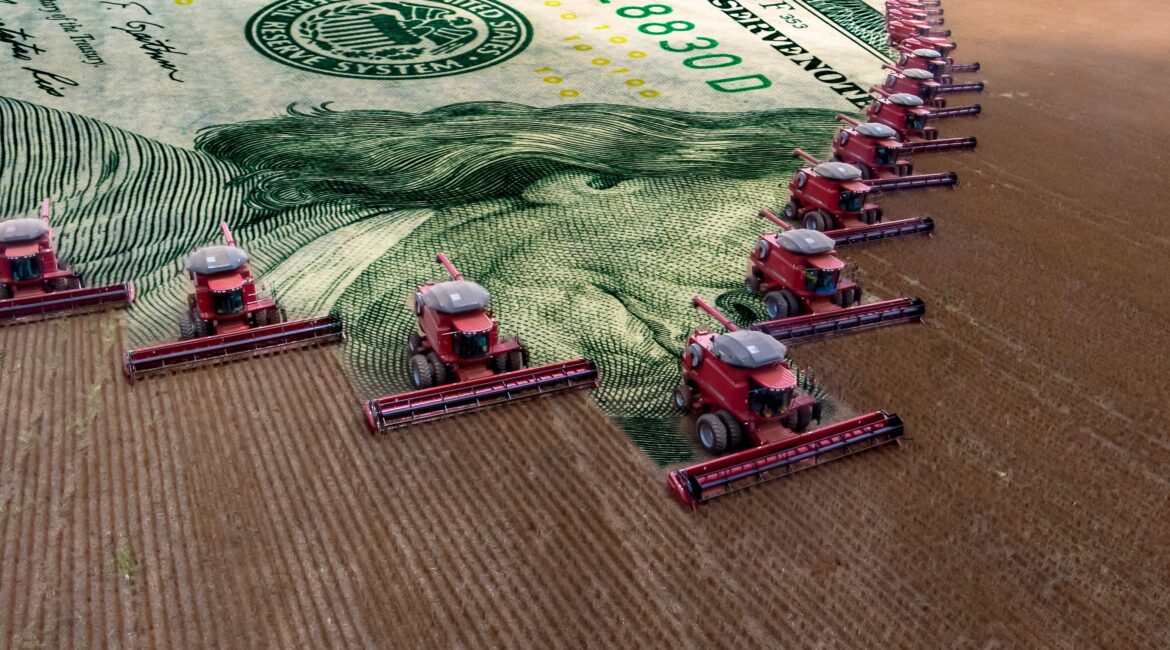2023 Farm Economy Summary
The USDA released its final Farm Sector Income Forecasts for 2023 (USDA ERS – Farm Sector Income Forecast) at the end of November. While 2022 was the strongest year on record, posting the highest net cash farm income and net income ever recorded, the best estimates indicate 2023 numbers will be reduced by 17.4% and 21.1%, respectively. While those are large drops, it is essential to remember that 2023 net farm income, forecasted at $151.1 billion, remains approximately 25% above the 2003-2022 average. There are several factors contributing to this year-over-year decline.
Crop and animal receipts are forecasted to decline. Fruits and nuts are the only commodities expected to experience increased receipts, as prices in those sectors, particularly tree nuts, are beginning to recover from pandemic-related supply chain issues. On the livestock side, milk, eggs, and poultry (broilers and turkeys) are expecting reduced receipts. Cattle are the only category expecting an increase in gross receipts, as a run-up in the cattle market is more than expected to offset herd liquidation (Cow and Heifer Slaughter Indicates Continued Herd Liquidation | Drovers), resulting in all-time price highs experienced in 2023 in the live cattle market. The corn market is expecting increased ending stocks compared to last year, as a below trend yield (173 bushels per acre, stronger than expected at times given drought conditions in key regions) has been more than offset by a larger than expected planted acres, estimated at 94.868 million acres, around 6 million more acres than last year, and the 3rd highest year on record, behind only 2012 and 2013 (NASS). This expected supply and year-end stocks-to-use ratio have kept corn prices below the highs experienced in 2022 and on a downward trajectory through most of 2023. Soybeans expect lower end-of-year stocks than corn, and quarter-four futures prices have reflected this sentiment.
In addition to reduced receipts, the USDA is expected to continue its multiyear pullback of direct government payments, forecasted at $12.1 billion in 2023, below the $15.6 billion in 2022, and over $33 billion below the high experienced in 2022. Furthermore, total production expenses are forecasted to increase slightly from 2022, when input prices generally experienced a significant run-up. Feed, labor, and livestock purchases, which are the largest categories of farm expenses, are mixed. While total feed expenses are expected to decline, labor and purchases will increase, albeit less than in 2022. Also of note is the increase in interest expenses and decrease in fertilizer expenses (down 14.1%). Overall, seed and pesticide expenses are not expected to change substantially year-over-year.
How have these factors affected farm-wide credit conditions? First, land sales have slowed this year as interest rates have increased (AgLetter: November 2023 – Federal Reserve Bank of Chicago (chicagofed.org)). While overall land values have continued to increase, the pace has slowed over the last two years. Both the causes and impacts are multi-faceted (Land Sales Slow in Response to Higher Rates | Farmer Mac). Multiple regional Federal Reserves have surveyed agricultural credit conditions in their regions, with generally consistent outlooks. Increasing interest rates, lower commodity prices, drought concerns, and higher operating expenses increased lender concerns across regions and commodities. Tightening cash positions, associated with reduced farm income in key agricultural regions (AgLetter: November 2023 – Federal Reserve Bank of Chicago (chicagofed.org), Farm incomes fell going into harvest, but finances remained solid | Federal Reserve Bank of Minneapolis (minneapolisfed.org)) has contributed to lender pessimism. While overall loan demand was generally flat over the year, there is a case to be made that a drying up of cash and reduced ‘sticker shock’ – as well as the possibility of the Federal Reserve reducing interest rates in 2024 – will contribute to increased loan demand in 2024. Furthermore, underlying financial fundamentals remain strong – at least industry-wide. While working capital is expected to drop across the industry, as producers experience lower net income and utilize cash for capital expenditures and operating expenses in an increasing cost-of-capital environment, this is less likely to be sustainable or make economic sense throughout 2024. The potential increase in loan demand, coupled with improving debt-to-asset ratio (Farm Income Forecast Reveals a Mixed Bag | Farmer Mac) and softening credit conditions, imply that 2024 will offer unique opportunities for alternative lenders who understand the industry’s cyclical nature.


About the Author: Taylor Kaus, Conterra Analyst
Taylor Kaus joined Conterra in 2020 and focuses on analysis of credit and operation stability as part of the underwriting process. This work has focused on understanding broad agricultural market trends and how individual borrowers and applicants operate in those environments. Taylor grew up in western Nebraska, spending time on his grandpa’s farm, branding cattle and baling hay. He received his Bachelor of Science and Master of Science in Agricultural Economics and Statistics from the University of Nebraska. Taylor is currently a Level II CFA Candidate.


About Conterra Ag Capital:
Conterra Ag Capital is a private agricultural lender that provides borrowers, from family farms to large agribusiness, a full portfolio of flexible lending and financial solutions. Based in West Des Moines, Iowa, and with team members around the country, Conterra has leadership with decades of ag finance experience. Conterra’s deep understanding of agriculture and the overall ag economy allows the company to quickly adapt to the needs of today’s producers. Conterra partners with community banks and lenders, brokers and correspondents and manages assets for hedge funds, insurance companies and private investors to provide a broad spectrum of loan products supporting American agriculture.
Disclaimer: Please note that the information provided in this article is for educational and informational purposes only, and should not be construed as financial or investment advice. While we have made every effort to ensure the accuracy and reliability of the information presented, Conterra Ag Capital and its affiliates make no representation or warranty as to the completeness, correctness, timeliness, suitability, or validity of any information contained in this article. You should always consult a qualified financial advisor, tax professional, or other qualified professional for advice on your specific financial situation.

